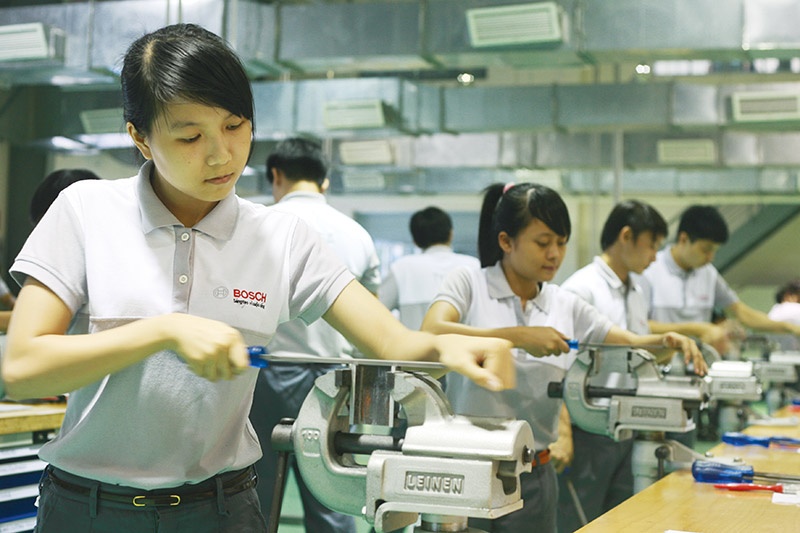Ensuring practicality of investment criteria
 |
| Nguyen Dinh Nam - CEO, IPA Vietnam |
The criteria are suitable for the country’s economic direction, which is proactively attracting and cooperating in select foreign investment, taking quality, effectiveness, technology, and environmental protection as key assessment criteria. They will also prioritise projects with advanced clean technologies with modern governance and high added value.
Compared to the general policy, these criteria are decided quantitatively and collected from practical experience, the economy’s indigenous capacity in collaboration with international experience from Malaysia, Thailand, Singapore, and Japan.
The proposal to build a criteria framework is a reasonable requirement in the context that current foreign-invested ventures in Vietnam are mainly of a small scale. Statistics published by the MPI show that by the end of December 2021, the country had tens of thousands of projects with capital of less than $50 million, accounting for 96.4 per cent of the total number of foreign-invested projects.
The land-use efficiency of many is also low. The average investment rate per one hectare of land in the processing and manufacturing sector is only $3.7 million. They mainly use medium technology, mostly focusing on certain stages in labour-intensive industries such as garments and textiles, footwear, wood processing, electronics, automobile assembly, and some food processing industries.
Meanwhile, the Ministry of Industry and Trade said the spillover effects of the foreign-invested sector on domestic enterprises have been limited. Efficiency and technology transfer from foreign enterprises in Vietnam are lower than in other countries in the Southeast Asian region.
The benefit of issuing quantitative criteria is understandable. However, the application of the criteria framework needs flexibility, otherwise, it will become a two-edged knife. We can see that when multinational manufacturers such as Samsung, LG, and Toyota invest in Vietnam, they also take their satellites to the country to create a supply chain. A majority of vendors have small- and medium-sized manufacturers and they just produce a small part.
 |
| Some major companies want to use more local talent, but domestic groups often cannot meet their criteria, Photo: Le Toan |
For example, a vendor of Samsung invests in Vietnam to manufacture cable or glue for its mobile phones’ screens. The vendor can meet the criteria on land usage, labour use, and environmental protection, but may fail to meet criteria relating to tech content and the contribution to the state budget.
Thus, if the government agencies apply strict and mechanical criteria, the investors will simply either choose another location with softer criteria or remove their intention to pour money into Vietnam altogether.
If the situation prolongs for a long time, these influential groups may have to reconsider plans to expand their operations in Vietnam due to vendor shortages. As a result, the foreign capital inflow will be impacted.
When working with our partners, I have seen this situation come up in the likes of Bac Ninh province. It issues a “two low, three high” policy to filter foreign-invested projects. Projects have to commit to using a few areas and a few labour forces, but ensure high-tech manufacturing lines and are highly committed to the environment and the state budget contribution.
The application of the above policy will help Bac Ninh filter high-tech foreign-invested projects. However, it is a barrier for manufacturers, especially vendors for large-scale groups. IPA Vietnam’s partners from Denmark and Hong Kong have to cancel their plans in Bac Ninh due to failure in meeting all of the province’s conditions despite being vendors of multinational groups.
The question is how to apply the criteria flexibly. In my opinion, during appraising the projects, cities and provinces should consider the target of the investors. If they are vendors, they just need to meet a major part of the criteria framework. In localities that do not have advantages in attracting overseas capital, the government can allow them to offer more incentives if they meet enough criteria.
In addition, in order to ensure the practicability of the criteria, the MPI needs to determine quantitative criteria, while simultaneously cooperating with relevant ministries and agencies to build and issue guidelines for specific objects.
Furthermore, in order to ensure synchronisation, it is necessary to foster telecommunication work to popular criteria for localities and investors, organise training courses for staff who are in charge of project management and promotional work, and hold meetings to share experience in applying the policy.
An important requirement is that local authorities need to organise regular meetings to review the implementation process and apply punishments to agencies that do not comply with criteria, causing barriers to attracting foreign capital. In particular, there is a need for strict admonishments for staff who abuse their positions to cause difficulties for foreign investors.
What the stars mean:
★ Poor ★ ★ Promising ★★★ Good ★★★★ Very good ★★★★★ Exceptional
Related Contents
Latest News
More News
- Kolon signs $48 million airbag supply deal with Autoliv (December 15, 2025 | 18:14)
- National Assembly approves Vinh–Thanh Thuy expressway project (December 15, 2025 | 18:02)
- Quang Tri green-lights $1.59 billion LNG-fired power project (December 15, 2025 | 17:59)
- Stress laid on high-quality FDI inflows (December 15, 2025 | 11:00)
- Can Tho utilises its growth advantages (December 15, 2025 | 09:09)
- Ca Mau unlocking potential to shape a more sustainable future (December 15, 2025 | 09:02)
- Major projects to be inaugurated nationwide (December 15, 2025 | 08:00)
- MoF workshop highlights mounting concerns over ODA on-lending costs (December 12, 2025 | 16:05)
- National Assembly approves pilot mechanisms to accelerate major projects in Hanoi (December 12, 2025 | 11:29)
- Legislation gives government flexibility for loan guarantees (December 11, 2025 | 18:04)

 Tag:
Tag:






















 Mobile Version
Mobile Version